Ankita Agarwal
Wright State University
Debias-CLR: A Contrastive Learning Based Debiasing Method for Algorithmic Fairness in Healthcare Applications
Nov 20, 2024



Abstract:Artificial intelligence based predictive models trained on the clinical notes can be demographically biased. This could lead to adverse healthcare disparities in predicting outcomes like length of stay of the patients. Thus, it is necessary to mitigate the demographic biases within these models. We proposed an implicit in-processing debiasing method to combat disparate treatment which occurs when the machine learning model predict different outcomes for individuals based on the sensitive attributes like gender, ethnicity, race, and likewise. For this purpose, we used clinical notes of heart failure patients and used diagnostic codes, procedure reports and physiological vitals of the patients. We used Clinical BERT to obtain feature embeddings within the diagnostic codes and procedure reports, and LSTM autoencoders to obtain feature embeddings within the physiological vitals. Then, we trained two separate deep learning contrastive learning frameworks, one for gender and the other for ethnicity to obtain debiased representations within those demographic traits. We called this debiasing framework Debias-CLR. We leveraged clinical phenotypes of the patients identified in the diagnostic codes and procedure reports in the previous study to measure fairness statistically. We found that Debias-CLR was able to reduce the Single-Category Word Embedding Association Test (SC-WEAT) effect size score when debiasing for gender and ethnicity. We further found that to obtain fair representations in the embedding space using Debias-CLR, the accuracy of the predictive models on downstream tasks like predicting length of stay of the patients did not get reduced as compared to using the un-debiased counterparts for training the predictive models. Hence, we conclude that our proposed approach, Debias-CLR is fair and representative in mitigating demographic biases and can reduce health disparities.
Mining Themes in Clinical Notes to Identify Phenotypes and to Predict Length of Stay in Patients admitted with Heart Failure
May 30, 2023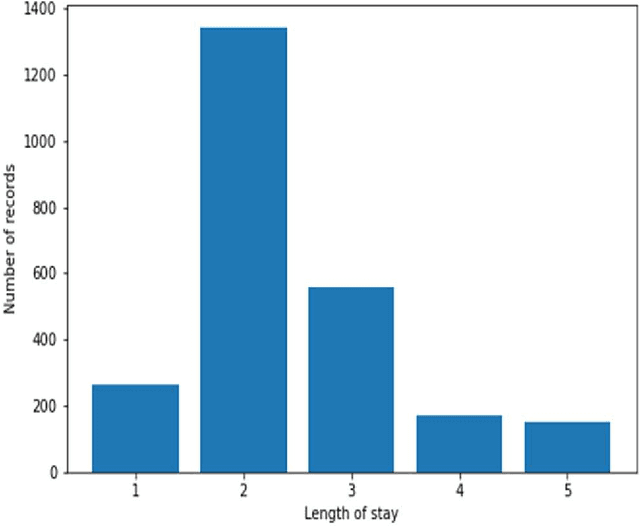
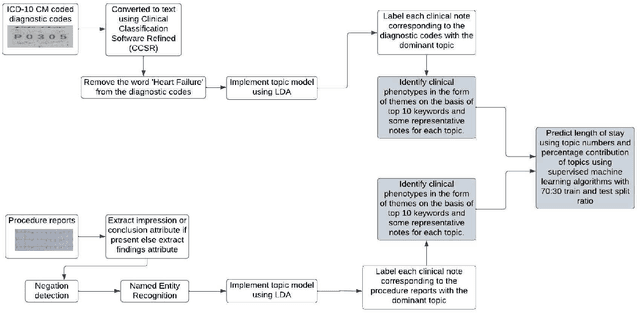
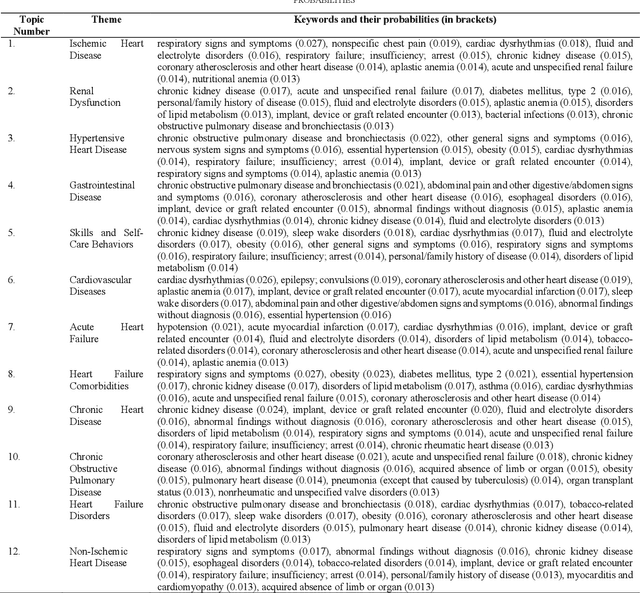
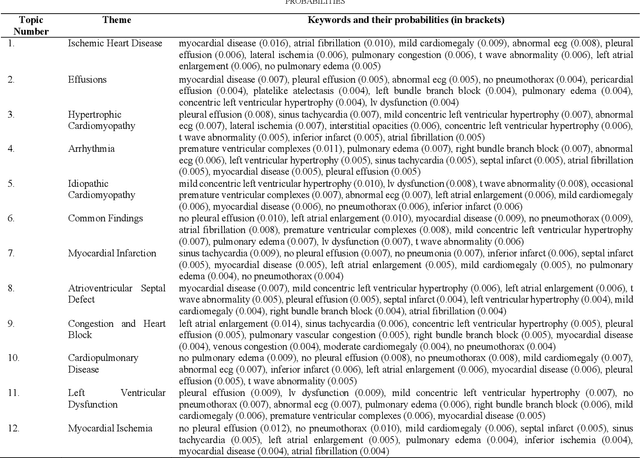
Abstract:Heart failure is a syndrome which occurs when the heart is not able to pump blood and oxygen to support other organs in the body. Identifying the underlying themes in the diagnostic codes and procedure reports of patients admitted for heart failure could reveal the clinical phenotypes associated with heart failure and to group patients based on their similar characteristics which could also help in predicting patient outcomes like length of stay. These clinical phenotypes usually have a probabilistic latent structure and hence, as there has been no previous work on identifying phenotypes in clinical notes of heart failure patients using a probabilistic framework and to predict length of stay of these patients using data-driven artificial intelligence-based methods, we apply natural language processing technique, topic modeling, to identify the themes present in diagnostic codes and in procedure reports of 1,200 patients admitted for heart failure at the University of Illinois Hospital and Health Sciences System (UI Health). Topic modeling identified twelve themes each in diagnostic codes and procedure reports which revealed information about different phenotypes related to various perspectives about heart failure, to study patients' profiles and to discover new relationships among medical concepts. Each theme had a set of keywords and each clinical note was labeled with two themes - one corresponding to its diagnostic code and the other corresponding to its procedure reports along with their percentage contribution. We used these themes and their percentage contribution to predict length of stay. We found that the themes discovered in diagnostic codes and procedure reports using topic modeling together were able to predict length of stay of the patients with an accuracy of 61.1% and an Area under the Receiver Operating Characteristic Curve (ROC AUC) value of 0.828.
Predicting Thermoelectric Power Factor of Bismuth Telluride During Laser Powder Bed Fusion Additive Manufacturing
Mar 28, 2023Abstract:An additive manufacturing (AM) process, like laser powder bed fusion, allows for the fabrication of objects by spreading and melting powder in layers until a freeform part shape is created. In order to improve the properties of the material involved in the AM process, it is important to predict the material characterization property as a function of the processing conditions. In thermoelectric materials, the power factor is a measure of how efficiently the material can convert heat to electricity. While earlier works have predicted the material characterization properties of different thermoelectric materials using various techniques, implementation of machine learning models to predict the power factor of bismuth telluride (Bi2Te3) during the AM process has not been explored. This is important as Bi2Te3 is a standard material for low temperature applications. Thus, we used data about manufacturing processing parameters involved and in-situ sensor monitoring data collected during AM of Bi2Te3, to train different machine learning models in order to predict its thermoelectric power factor. We implemented supervised machine learning techniques using 80% training and 20% test data and further used the permutation feature importance method to identify important processing parameters and in-situ sensor features which were best at predicting power factor of the material. Ensemble-based methods like random forest, AdaBoost classifier, and bagging classifier performed the best in predicting power factor with the highest accuracy of 90% achieved by the bagging classifier model. Additionally, we found the top 15 processing parameters and in-situ sensor features to characterize the material manufacturing property like power factor. These features could further be optimized to maximize power factor of the thermoelectric material and improve the quality of the products built using this material.
Leveraging Natural Learning Processing to Uncover Themes in Clinical Notes of Patients Admitted for Heart Failure
Apr 14, 2022
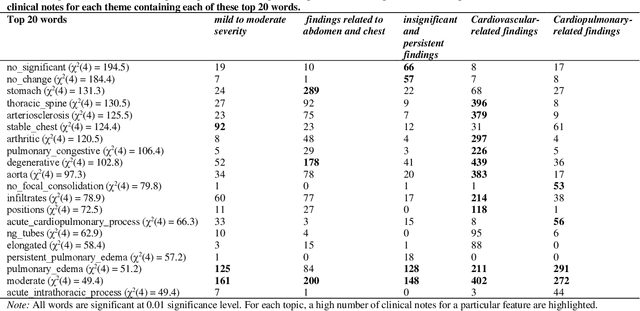
Abstract:Heart failure occurs when the heart is not able to pump blood and oxygen to support other organs in the body as it should. Treatments include medications and sometimes hospitalization. Patients with heart failure can have both cardiovascular as well as non-cardiovascular comorbidities. Clinical notes of patients with heart failure can be analyzed to gain insight into the topics discussed in these notes and the major comorbidities in these patients. In this regard, we apply machine learning techniques, such as topic modeling, to identify the major themes found in the clinical notes specific to the procedures performed on 1,200 patients admitted for heart failure at the University of Illinois Hospital and Health Sciences System (UI Health). Topic modeling revealed five hidden themes in these clinical notes, including one related to heart disease comorbidities.
Leveraging Natural Language Processing to Mine Issues on Twitter During the COVID-19 Pandemic
Nov 03, 2020



Abstract:The recent global outbreak of the coronavirus disease (COVID-19) has spread to all corners of the globe. The international travel ban, panic buying, and the need for self-quarantine are among the many other social challenges brought about in this new era. Twitter platforms have been used in various public health studies to identify public opinion about an event at the local and global scale. To understand the public concerns and responses to the pandemic, a system that can leverage machine learning techniques to filter out irrelevant tweets and identify the important topics of discussion on social media platforms like Twitter is needed. In this study, we constructed a system to identify the relevant tweets related to the COVID-19 pandemic throughout January 1st, 2020 to April 30th, 2020, and explored topic modeling to identify the most discussed topics and themes during this period in our data set. Additionally, we analyzed the temporal changes in the topics with respect to the events that occurred during this pandemic. We found out that eight topics were sufficient to identify the themes in our corpus. These topics depicted a temporal trend. The dominant topics vary over time and align with the events related to the COVID-19 pandemic.
 Add to Chrome
Add to Chrome Add to Firefox
Add to Firefox Add to Edge
Add to Edge